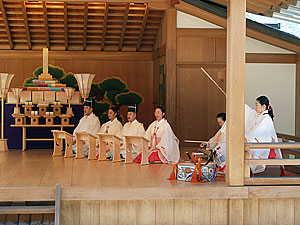Mesmerized by the Japanese Arts
By Bill Roberts
Bill Roberts, author of “A Portrait of Oomoto,” gave the following lecture at the Himeji Cultural Center on Feb. 25, 2007, under the auspices of Jinrui Aizenkai (Universal Love and Brotherhood Association). The lecture was mainly aimed at Japanese who are not members of Oomoto. The audience was about half Oomoto followers and half non-followers.
Konichiwa. Bill Roberts des. Yoroshiku. Onegaishimasu.
It is a pleasure to be here today. I look forward to talking about the Japanese arts as I experienced them at Oomoto, and the impact they’ve had on me.
Before I continue, let me offer a disclaimer. Although I was invited to speak today by Jinrui Aizenkai, I do not officially represent it or Oomoto. I am not a member of either organization. In fact, I do not belong to any religious group. Anything I say is my own opinion based on my research and my experiences of the past eight years. Any errors I make in representing Oomoto are my own honest mistakes. Oomoto has a fascinating history, which I am not going to delve into deeply. I’m going to tell you about my encounter with the arts at Oomoto. My interest in Japan began with the traditional arts, specifically ceramics.
I was also asked to show you some of the thousands of photos I’ve taken. At appropriate points, I’ll show photos that illustrate my speech. I’ll say something about each group of photos, but I will not comment on any single picture. Each image tells its own story.
I first visited Japan in 1999 and have returned at least once a year since. I was nearly 50 years old when I first visited, but Japan had always been a part of me. You see, my parents met here after World War II. My father was an Army officer and my mother was a civilian secretary in the occupation. They met in Tokyo in 1946 and were married there in 1947.
My parents traveled widely in Japan, taking trips to Hokkaido, Kyoto, and elsewhere. They climbed Mount Fuji, they went sailing on Lake Biwa and they had many other experiences they would cherish the rest of their lives.
I was their first child, born in the United States in 1950. However, I was conceived in April 1949 about three months before they left Japan. So I was literally “made in Japan,” just like those transistor radios that began to appear in the U.S. in the 1950s. My first trip to Japan, in April 1999, took place exactly fifty years after I was conceived here.
I have traveled widely, and lived in several countries, but Japan’s beauty and culture hold me like a magic spell, and this is never stronger than when I visit Oomoto. For me, Oomoto is Japan and Japan is Oomoto.
When I’m not visiting Oomoto, I live in Silicon Valley, where I work as a freelance journalist, writing about the electronics industry. Silicon Valley is just a nickname for Santa Clara County, California, the birthplace of the semiconductor industry. The main city is San Jose, about 90 kilometers south of San Francisco.
At Oomoto I’ve had the opportunity to participate in the arts, rituals and interfaith meetings, and to visit fifteen of its sixty branches. I have watched innumerable religious ceremonies, plus weddings, funerals, tea ceremonies, art exhibits and performances, and even the purification rites for a new car. Through an interpreter, I have interviewed more than 100 Oomoto followers and photographed them in their homes, offices, and shrines.
Oomoto is one of Japan’s New Religions, a denomination of Sect Shinto. It was founded by Nao Deguchi of Ayabe, and it has always had a female Spiritual Leader, as dictated by its scripture. Nao was born in 1837 and died in 1918. Guided by divine inspiration, she founded Oomoto in 1892. A young man from Kameoka joined her in 1900 as Co-Founder, married her daughter, Sumiko, and took the name Onisaburo Deguchi. Onisaburo was born in 1871 and died in 1948. He was a multifaceted man, a highly public figure, and often controversial.
One thing that makes Oomoto different from most religions is its doctrine that “all religions come from the same great source,” as Onisaburo put it. Because Oomoto followers believe all religions come from the same source, they promote religious tolerance, and they did so long before interfaith dialogue became fashionable in the late 20th century.
Onisaburo also declared that art is the mother of all religion, and that God is the greatest artist. He urged people to do art for spiritual reasons, by which he meant to honor God. So Oomoto followers practice the traditional arts, including tea ceremony, tanka poetry, Noh drama, calligraphy, martial arts, and ceramics.
The two ideas of art and interfaith have often intersected. In the 1970s, Oomoto took an art exhibit to several cities in Europe and North America. It became a catalyst for interfaith work. For example, Oomoto held a worship service in 1975 at the Cathedral of St. John the Divine in New York City in conjunction with the art exhibit, which the cathedral museum hosted for several months. Two years later, the cathedral priests reciprocated by performing an Episcopalian service in Ayabe. The relationship continues to this day.
The traveling exhibit included art works from many Deguchi family members, but the main attraction was Onisaburo’s tea bowls. Onisaburo was a talented amateur artist skilled in many arts, including narrative writing, poetry, calligraphy, painting and ceramics. In a burst of artistic energy near the end of his life, he made by hand – not on a wheel – about 3,000 raku-style tea bowls.
These bowls were not anything like standard raku bowls. Onisaburo and the professional ceramist who assisted him used colors no one had ever experimented with previously. In fact, these are clearly not wabi sabi, and Onisaburo did not intend for them to be used in tea ceremony. In a short raku-style firing, they produced these colorful tea bowls that look more like French Impressionist paintings than they do traditional tea bowls. One critic called them “yowan,” which means “scintillating bowls.”
Onisaburo’s yowan brought me to Japan the first time.
I was working with a ceramics teacher in California named Coeleen Kiebert. She knew about Oomoto because Oomoto used to conduct a traditional arts seminar for foreigners each year. Coeleen had attended in the 1980s.
Several months after I started to work with Coeleen in 1998, she announced she would take a group to Oomoto the following year. Coeleen told us about Onisaburo and showed photos of his tea bowls. I had just started working in clay and was enthralled by his bowls. I knew nothing about tea bowls, tea ceremony or Oomoto. But I wanted to see these bowls for myself, and to learn more about the man who produced them.
By the end of that visit in 1999 I was smitten with Japan, especially its arts. I returned to Oomoto with Coeleen in 2000 and 2001.
Then because of my writing skills, Oomoto invited me to work on several editorial projects. I came for three months at the end of 2001 and returned each year after as a volunteer. This led to the book project. From October 2004 to December 2005, I spent 14 months living at Oomoto to write and photograph a book. The Oomoto Foundation commissioned the work, but gave me complete editorial freedom. They asked me to write a book in English to explain Oomoto to people outside Japan. “A Portrait of Oomoto” was published last year.
I was mesmerized the first time I saw Onisaburo’s yowan in the Oomoto museum in Kameoka. Each is a rare gem infused with the spirit of an artist who was a mystic and a visionary. His tea bowls touched me. On later visits I had opportunities to hold some of them, to feel their energy and to drink tea from them. In some cases, my visits to the homes of Oomoto followers prompted the hosts to find yowan they had stored in their closets years earlier.
On later visits to Japan, I also had an opportunity to make tea bowls much the same way Onisaburo did, but more about that later.
Onisaburo emphasized that practicing the arts, not the outcome, is the important thing. He said: “Art is not the preserve of the specialist, but a Way for every ordinary human being to himself and to God.”
The key word is Way. In Japan, you speak of the Way of Tea or the Way of Zen. I understand “a Way” to be a journey not a destination, a process not a product. For Oomoto followers, art is a Way.
Kyotaro Deguchi, a grandson of Onisaburo, explained it this way: “Religion, art and living are all one. I think this is common ground for Oomoto followers. We don’t separate the three; we try to integrate them.”
Some followers may have joined Oomoto for the arts, but they came for many other reasons, too: an illness, a life crisis or the teachings. However, among the 100 followers I interviewed for my book, most practiced at least one art. Some immersed themselves in several arts.
Tanka, Noh and tea are three popular arts at Oomoto. I knew little about these before I came to Japan. I’d like to say a few words about each of these.
As a writer and poet, I was very interested in learning about tanka. Writing tanka appears to be one of the easiest art forms to practice. All you need is pencil and paper. But people tell me it is hard to sustain, and as a writer I appreciate that. At Oomoto, they also turn it into something more elaborate -- a collective performance called Utamatsuri.
In ancient times, Japanese people gathered to recite or chant poems for entertainment. The festivals were often held at a shrine, on top of a mountain, beside a river or in the market place.
When he was a boy, Onisaburo studied literature, poetry and writing with his grandmother, who was a classically trained poet. She also told him about Utamatsuri.
Onisaburo wrote thousands of 5-line, 31-sylable tanka, which is the type of poem used in the Utamatsuri.
Today, thousands of followers write tanka, also called waka, and many submit their work to a monthly journal that Oomoto publishes. As a writer, I find this inspiring.
Onisaburo revived the Utamatsuri in 1935. Since the 1950s, Oomoto has performed two Utamatsuri in most years.
One is in August, as part of its Summer Festival, held in Kameoka to celebrate Onisaburo’s birthday. The other is held in some other month at one of the branches.
Utamatsuri is one example of how Oomoto melds traditional arts with spiritual practice. In Utamatsuri, each poem is a prayer and each prayer is a poem. Hisao Deguchi, a grandson of Onisaburo and chief of the Oomoto Art Department, explained it this way: “You write the poems not about yourself but about peace and about others as an offering at the altar.”
Utamatsuri is based on a Japanese myth. Maybe you know it already.
Susanoo no Mikoto slew a dragon to rescue Kushinadahime and her parents. He married Kushinadahime and brought peace to the land. In celebration he composed a tanka, said to be Japan’s first poem. When Susanoo felt low, Kushinadahime played music by plucking on a bowstring with an arrowhead. She also fastened the bowstring to the bottom of a wooden tub and beat it with a stick.
Oomoto incorporates all aspects of the myth into its Utamatsuri. The chief priest opens the festival by reciting Susanoo’s poem. Then three young women representing Kushinadahime and her parents perform a purification dance. The dancers also return at the end. From beginning to end, the event is accompanied by yakumogoto and bow drum.
Several months before an Utamatsuri, Oomoto followers submit poems to the Art Department. Selectors choose between forty and fifty to be chanted. The chanters, men and women, number between seven and nine, and practice for months.
I saw one Utamatsuri in Kameoka, and saw two performed by branches. One was on a sunny October afternoon on a remote mountaintop in Okayama Prefecture, and the other was on a crisp November night with a full moon in Tokushima.
The setting is almost as important as the poetry!
Like the Utamatsuri, the Noh drama is also an ancient performance art rooted in myth. In this myth, the Sun Goddess became angry and shut herself in a cave, plunging the world into darkness. Other gods and goddesses gathered outside to dance. When the Sun Goddess peeked out to watch, she restored light to the world. The myth was the origin of sacred dances done at shrines in ancient times. These shrine dances were the roots of Noh.
Noh came to Oomoto after World War II. Onisaburo preached the importance of the arts, but his daughter, Naohi, the Third Spiritual Leader, really promoted the arts starting in the early 1950s. The fourth and fifth spiritual leaders continued to emphasize the arts.
Naohi was a tea master, a ceramist and an accomplished Noh performer. Men traditionally performed Noh; Naohi was one of the first female dancers and an advocate of women in Noh. Her daughter, Kyoko, the Fourth Spiritual Leader, also became an accomplished Noh performer and a teacher of the yakumogoto. I have met many female followers who were inspired by Naohi or Kyoko to practice Noh.
A full Noh drama lasts about an hour. At Oomoto, they usually just perform individual shimai, or dance. The longest last fifteen to twenty minutes. Short shimai are accompanied only by utai – chanting-- and longer shimai by chanting and musicians. Many followers take part in some aspect of Noh – shimai, utai, playing an instrument or all three.
Miroku Noh is Oomoto’s annual Noh festival held each May on a stage in the shrine in Ayabe. Most of the performers are followers; the chanters are a mix of followers and professionals from two Noh troupes in Kyoto who participate each year.
I sat through the entire day once. Much to my surprise about halfway through I realized how much I was enjoying the performances. I had assumed they would be monotonous, but I was wrong for several reasons. The voices were great; any of them, the professionals or the amateurs, could have sung many different styles. The dancers were polished and highly practiced. The kimonos were beautiful.
It also helped that I had a choice spot in front and shot photos all day, forcing me to be mindful of the action. This is an appropriate place to note that my travels to Japan rekindled my passion for photography, which I had given up many years earlier.
Another collective art form is the tea ceremony.
Today it is hard to imagine Oomoto without tea. But it didn’t become important until after World War II when the Third Spiritual Leader began to emphasize the arts.
Oomoto holds tea ceremony after each monthly service. Many followers have studied tea somewhat and some have studied for decades. Many branches have regular tea practice for members.
Kurenai Deguchi, a great-great granddaughter of Nao, was a tea teacher before she became the Fifth Spiritual Leader in 2001. Since becoming Spiritual Leader, she has also taken up the art of the tea bowl.
One long-time Oomoto follower from Okazaki City, who has studied and taught tea for decades, told me: “Tea is the basis of daily life.”
He said: “When you learn tea you learn about a lot of things. It is not something separate from daily life.”
Tea had led him to other arts. “If you study tea you also have to learn flower arranging, write poems and practice calligraphy. I have studied flower arranging and tanka for many years.”
I have asked many Oomoto followers if tea ceremony is a religious ritual. It is in a way but it isn’t, is the common answer.
One Oomoto tea master, Minoru Sawada, told me: “It is a ritual and some part of it is like religion. But the idea is to learn how to live. Tea ceremony is a lesson in how to live life. It is the foundation of daily life.”
Oomoto followers are clear about one thing: Tea is not about acquiring and showing off expensive utensils. The tea master from Okazaki told me: “When I have tea ceremony my wife and I make the food. My utensils are not expensive. I use tea bowls I already have. It is not an aristocratic pastime.”
For Oomoto followers, tea is spiritual in the sense that it is a way to enter a special place where four ideals prevail: harmony, respect, purity and solitude. Personally, I learned the lesson of ichi go ichei (each moment is unique) from tea, and it is something I try to apply in other areas of my life.
Tea is also a collective art form. The tea master, the servers and the guests all have parts to play.
When Oomoto followers say they practice the arts to praise God, they really mean it. Let me give you just one example.
The Kameoka headquarters staff holds a day of Noh performances each autumn. I once watched this event. There were never more than a few people in the audience. The next day I asked one of the chanters: Was it disappointing there were so few people watching?
“Oh no,” he said. “It does not matter. We do it for God.”
In my opinion, Oomoto followers have done an important service to artists everywhere by keeping alive this art and religion idea.
The art-religion connection is as old as humankind, and not exclusive to Japan or Asia. In the West, however, we began to lose this perspective about 300 years ago, around the time of the Industrial Revolution. As the West became more material and commercial, art became prized for its financial, esthetic or utilitarian value. In doing research for my book, I learned that many Western artists do see a connection between art and spirituality. But few are comfortable discussing this idea.
One who is very comfortable is Coeleen Kiebert, my ceramics teacher.
Coeleen is now in her seventies, but even as a young artist and teacher she believed that art could and should be done as a spiritual practice. She found little support for this way of thinking in America. When she came to Oomoto, Coeleen felt validated for her notion that art could be a spiritual practice for anyone, and from that point on she was able to teach art from a spiritual perspective.
Coeleen once told me: “Oomoto was enormous validation that the practice of art is a spiritual practice. It gave me permission to teach my workshops from this spiritual perspective. I began to see my studio as a sanctuary. This all came out of my first visit to Oomoto.”
As a result of working with Coeleen and all my visits to Oomoto, I too see art as a spiritual practice. I also believe that all artists -- professional or amateur -- are spiritual seekers whether they realize it or not.
In my view, art as a spiritual practice could include any of the following:
Making art to praise and worship God; making art with an attitude that process not product counts, that each art-making moment is unique; making art as an activity that taps something deep in the unconscious that is bigger than the self; making art for what it teaches me about myself -- but not for the sake of deriving self importance.
Like Coeleen, I believe art is also spiritual when it has a healing effect. Coeleen herself has used art to help recover from personal tragedy, including the death of a son many years ago.
Let me tell you about the spiritual impact of art on one tragedy in my life.
Before he died in 1990, my brother Max was spiritually transformed by art.
Two and a half years younger than me, Max was my only sibling. Like Onisaburo, he exhibited extraordinary artistic talent at an early age, first in drawing and painting. A few years later he proved to be a musical prodigy.
Max spent his entire life in the arts. He studied at the California Institute of the Arts, one of the most prestigious art schools in America. He painted and sketched. He played piano, and wrote songs for the movies. He designed costumes and stage sets for plays, movies and television. He wrote and directed musical plays. He received several Emmy nominations for writing, costumes and set design for a children’s television show he helped create. He even designed toys, some of which were once included in an exhibit at the Louvre.
His entire life was a creative explosion and then he died two weeks before his thirty-eighth birthday. In his last two years, when he knew he was dying, he underwent a spiritual transformation thanks to art.
He directed his entire energy to just three things: First, learning to live in the moment with his fatal disease; second, writing songs that expressed his joy at life, his grief at dying and his understanding of the spiritual mystery of life and death. Third, he put the songs into a one-man show, which he performed before he died.
This was the first time I witnessed the spiritual power of art. Max used art to explore important matters of spirit in preparation for the next life. It was inspiring. The most inspirational part was that he knew he might not complete or perform the songs. In the end, he did record and perform them, but he did not know that would happen. And it did not matter. The act of creating the songs was the important part.
By the way, I have spent the last several months working on a memoir about Max, which I hope to publish someday.
Art has helped me heal, too. I told you I began to work with Coeleen in 1998, but I didn’t tell you under what circumstances. About six months before I began to work with her, my father died of brain cancer. I fell into a moderate depression, which lasted for months.
One night I was talking with two friends who had taken art courses from Coeleen, whom I had never met. They said she used art to explore matters of spirit. They said if I took one of her courses I would feel better. I only half believed them, but I was so depressed I was willing to try anything. Several weeks later I took my first workshop with Coeleen. The art work did help my depression. It was the first time I had worked in clay and I fell in love with it.
Besides whatever spiritual uplift I get from doing art, I really like clay because it reminds me of playing in the mud when I was a child. Ceramics involves the five basic elements: earth, water, air, fire and spirit. The clay is earth and water. The kiln is air and fire. The artist provides the spirit. I especially like to make tea bowls but I do not work on a wheel. I build by hand, similar to the way Onisaburo made his tea bowls.
I’ll never forget the first time I saw Jomon pots at the Kyoto National Museum. Some are 10,000 years old, the oldest pottery on earth. They are large vessels, made of coils without a wheel and fired in open pits that must have caused many to break. I am moved by these pots when I think of the unknown artists who made them ten millennia ago without considering whether they might occupy a place in a museum. They are great works of art, the spirit of the artist still present.
Whenever I start to make a tea bowl, I observe a moment of silence to remember that I am continuing an ancient tradition. I think Onisaburo would understand.
I have made hundreds of tea bowls in Coeleen’s studio. But I learned to make tea bowls from Hideki Nishijima, a professional potter in Kameoka. I met him on my first trip to Japan. During my longer stays at Oomoto, I worked in his studio once a week.
Nishijima is not an Oomoto follower. He’s a Buddhist. But he is the first to admit that his real spiritual path is in the studio.
We often talked about raku-style pottery. When Nishijima was young, he worked with a master potter who had once worked for a raku-style master.
The raku-style master was Shoraku Sasaki. He’s an Oomoto follower and his father was the professional potter who assisted Onisaburo.
Nishijima’s teacher did not specialize in raku-style but he taught Nishijima what he knew. Nishijima did not start making raku-style pottery until I began to talk to him about it.
To my surprise, when I came to Oomoto in 2004 to write the book, Nishijima had built a charcoal kiln so we could make raku-style tea bowls.
Since then, we have done many firings. This gave me a first-hand understanding of the process Onisaburo went through in producing his beautiful bowls. My bowls aren’t as beautiful as Onisaburo’s, but art is a Way, not a product.
After each firing with Nishijima, I would take photos of my bowls.
One day, an Oomoto staff member saw me doing a photo shoot. He did not speak English and I do not speak Japanese, but for a few minutes we were communicating with the help of those tea bowls. He seemed awestruck by my red raku-style bowls, one in particular. I told him to pick it up.
After he cradled it a few seconds, he smiled and declared: “Yowan.”
I was so stunned by his compliment that I did not know what to say.
Before I left Japan, I gave him the bowl. Because the bowl was made in Japan, I thought it should stay in Japan.
And because I was made in Japan, I will continue to return to Japan.
And I will continue to study the Japanese arts because they have made me a better person spiritually and otherwise.
Kyo-wa watashino hanashi-o. O-kiki kudasari. Arrigato gozaimashta.
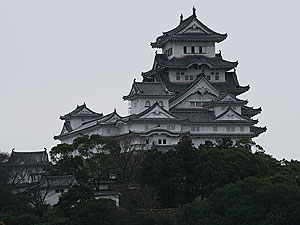
Himeji Castle, near cultural center
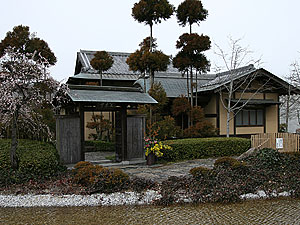
Traditional Japanese villa at cultural center
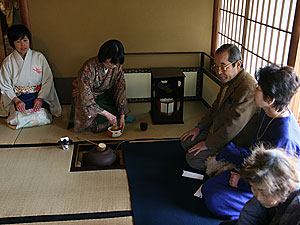
Oomoto followers from Harima branch serve tea
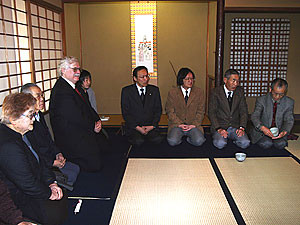
In the tearoom
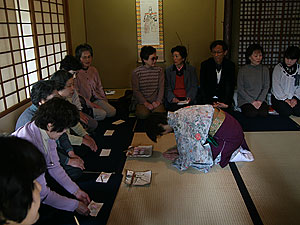
In the tearoom
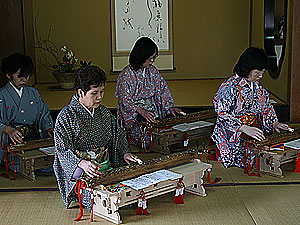
Yakumogoto performance by Oomoto members
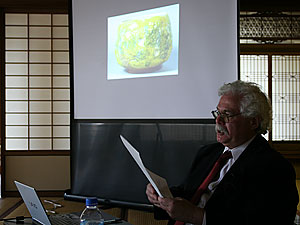
Bill Roberts speaks on impact of Japanese arts
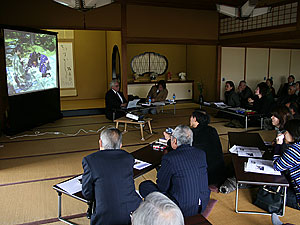
Illustrates speech with photos
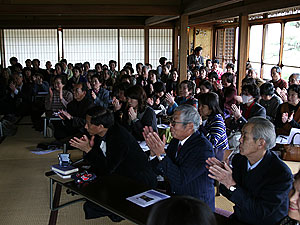
Audience number about 120
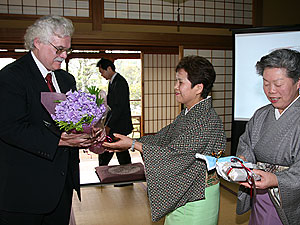
Flowers and chocolate for the lecturer
New Contents Thu, May 20, 2010
- Oomoto participates in Sant’Egidio conference : Dialogue among religions and cultures : On divided island nation of Cyprus By Bill Roberts
- Photo Album : Portraits of three branches: Shoko, Tanegashima and Aomori By Bill Roberts
- Oomoto FAQ
- A Letter from Oomoto : Of mountains and myths By Bill Roberts
- Polyglot poem festival The Utamasturi is going international — what’s next? By Bill Roberts
- Ethics education program captures the spirit of Bankyo Dokon By Bill Roberts
- A Letter from Oomoto : A year’s worth of adventure in a summer of branch visits By Bill Roberts
- In Kumamoto, it’s all about water – and fire By Bill Roberts
- A speech by Nevada Taylor at the Kii Branch in Wakayama Prefecture on April 13, 2008.:An Encounter With Oomoto Through Aikido
- Utamatsuri, Poem Festival, in Tokyo(on April 17, 2008)
- A speech by Neil Ryan Walsh at the Kobe branch on Mar. 9th, 2008.:Planting the Seeds of the Soul
- Meeting with the Fifth Spiritual Leader of Oomoto, Madame Kurenai Deguchi by Neil Ryan Walsh
- A speech by Neil Ryan Walsh at the Nagoya branch on Feb. 17th, 2008.:The Japanese Arts beyond National Boundaries
- To the Oomoto branch in Nagoya: City of Eel and Toyota by Neil Ryan Walsh
- A Speech by Nissim Ben Shitrit, Ambassador of Israel on the occasion of the Oomoto Setsubun Grand Festival in Ayabe February 3rd, 2008 : Japan and Israel : Two Lands Balancing the Needs of Traditional Culture and Modern Life. r
- A permanent memorial to Onisaburo (A Speech at the Autumn Grand Festival , November 6, 2007 : )By James Parks Morton, Founder and Chair, Emeritus of The Interfaith Center of New York
- Israel, Palestine and the Power of Poetry(Oomoto believes small efforts can have lasting ripple effects on people and peace)By Bill Roberts
- “Something Great”(This genetics pioneer, a friend of Oomoto, offers a clue to the mystery of life)By Bill Roberts
- Kamishima Cleanup (Harima branch members regularly visit this sacred island to keep the shrine tidy)By Bill Roberts
- Kyotaro Deguchi was one of six recipients of the 2007 James Parks Morton Interfaith Award
What is Oomoto?
- What is Oomoto?
- Spirtual Centers
- Founders and Spiritual Leaders
- History
- Organization and activities
- Teachings and scriptures
- Art Works of Founders and Leaders
Opinions[Archive]
- Statement of regret for the outbreak of war against Iraq (March 20,2003)
- Jinrui Aizenkai dispatched the "Urgent Appeal for a World (Global) Crisis" on March 14.
Grappling with Bioethics[Archive]
- Oomoto’s support for abolishing the death penalty (12, June 2003)
- The Oomoto Foundation protests any birth of a human clone baby. (5, January 2003)
- OOMOTO'S VIEW REGARDING JAPAN’S PERMITION TO THE RESERCH OF HUMAN EMBRYONIC STEM CELLS (ES cells)(12, June 2000)
Vistor’s Review[Archive]
- A speech by Bill Roberts at the Oomoto branch in Hiroshima after its monthly service on March 18, 2007:Encounters with war and peace
- How Bankyo Dokon changed one life by Linda Macphee
- A speech by Bill Roberts at the Hokuriku (Kanazawa) branch on Dec. 3, 2006:Ritual and myth -an encounter with ‘divine madness’
- A speech by Bill Roberts at the Himeji Cultural Center on Feb. 25, 2007:Mesmerized by the Japanese Arts
- A speech by Bill Roberts at the Kobe branch on Feb. 11th, 2007.:There are just human tears and human joy
- A Speech on the occasion of the Oomoto Setsubun Grand Festival in Ayabe February 3rd, 2007 : Egypt's role in Middle East peace
- Keynote Speech for the 28th World Federation Japanese Religionists Conference for World Peace in Tokyo (at Kokugakuin University, Novermber 29, 2006):Vision for Peace in the Middle East By Dr. Munther S. Dajani, Professor Dean, Faculty of Arts, Al Quds University, Jerusalem
- A speech to the Kyoto branch:Spiritual adventures in researching Oomoto leaders
- A Speech at The Oomoto Foundation on Monday, November 6, 2006 : Jordan's role in Middle East By Samir Nouri, Ambassador of the Hashemite Kingdom of Jordan
- A letter from Oomoto:The Young People of Tottori
- A speech by Bill Roberts on the occasion of the dedication ceremony for the new shrine of Tottori Branch By Bill Roberts Oct. 8, 2006
- A speech by Bill Roberts at the Oomoto branch in Hiroshima after its monthly service on March 18, 2007:Encounters with war and peace
- How Bankyo Dokon changed one life by Linda Macphee
- A speech at Setsubun : A Portrait of Oomoto By Bill Roberts Feb. 3, 2006
- New Publication ! By Bill Roberts Feb. 3, 2006 A Portrait of Oomoto
you can read this book in html => http://www.jinruiaizenkai.jp/English/en-kolumno/en-bill/en-sugao/billbook1en.html
E-mail below to order brobert1@ix.netcom.com
Current Topics
- Prayer Offering and World Religious Forum II
- Living the art of dialogue
- Kyotaro Deguchi was one of six recipients of the 2007 James Parks Morton Interfaith Award
Books
Online Books
- Divine Signposts by Onisaburo DEGUCHI
- The Creation of Meaning by Hidemaru Deguchi
- Bankyo Dokon(Seventy years of Inter-Religious Activity at Oomoto)
- Nao Deguchi — A Biography of the Foundress of Oomoto
- The Great Onisaburo Deguchi published by Aiki News
- Bankyo Dokon Seventy Years of Inter-Religious Activity at Oomoto
- Insearch of Meaning
- Nao Deguchi A Biography of the Foundress of Oomoto
- A Portrait of Oomoto By Bill Roberts
Oomoto international Archive
- The History of Oomoto (Jan.– Mar. 1980 — Apr.– Jun. 1982)
- The Ancestors; Friends or Foes? (Apr.– Jun. 1987)
- Tsukinamisai; The Sabbath of Shinto (Jan.– Jun. 1983)
- The Poem Festival at Oomoto; An Ancient Rite Lives Again (Oct.– Dec. 1981)
- Purification of the Universe ; Oomoto's Setsubun Festival (Apr.– Jun. 1981)
Links
Flowers at Ten'on-kyo & Baisho-en (photographs)
Contact
All rights reserved : the Oomoto Foundation Produced by the Netinformational Commission
Since : Mar. 7.1998 Last Update : Thu, May 20, 2010
E-mail : webmaster@oomoto.or.jp
Top Page Nihongo Esperanto Português Roomazi



